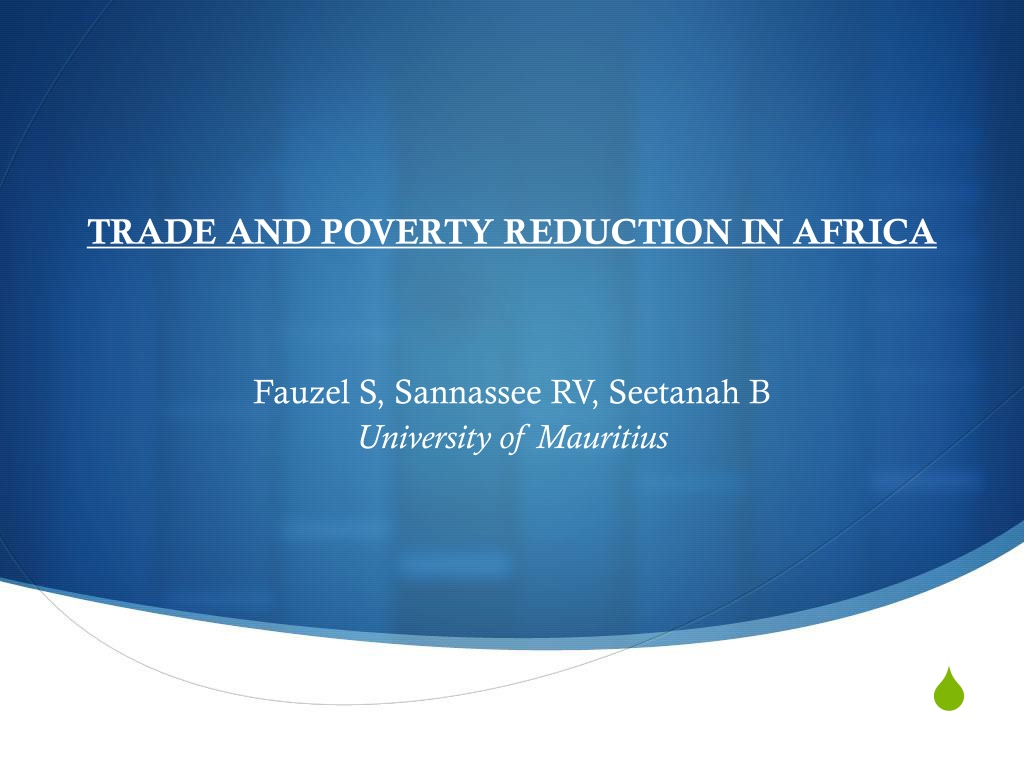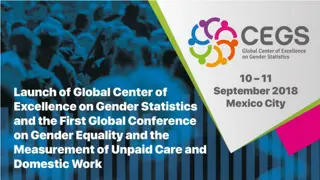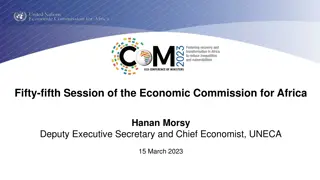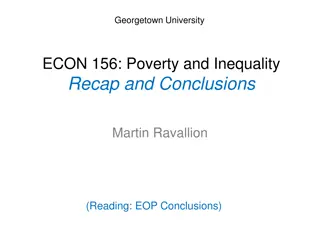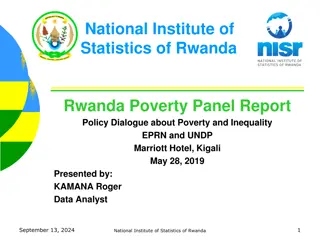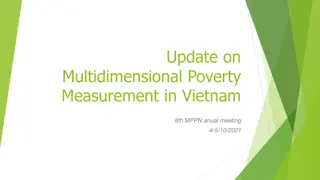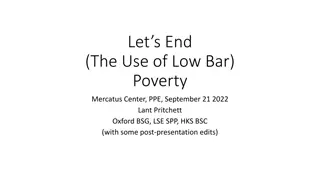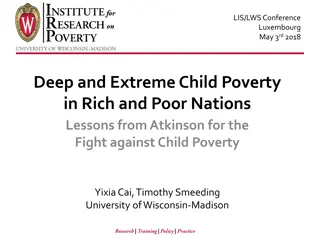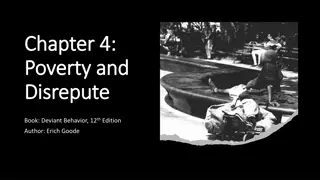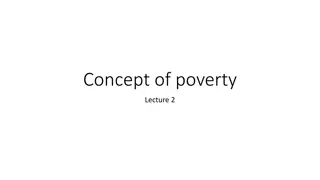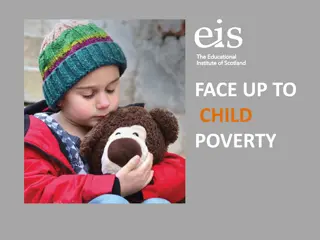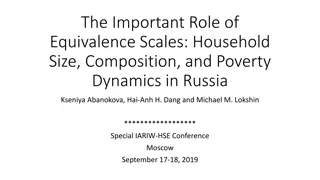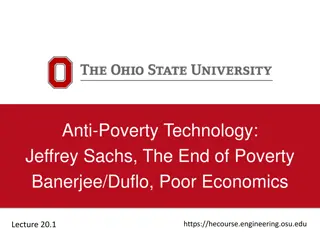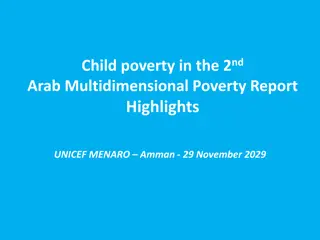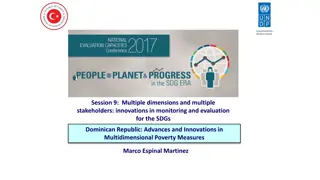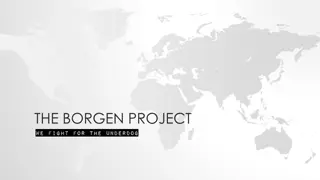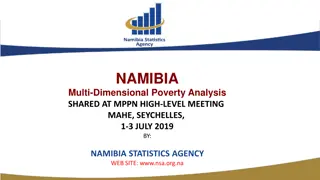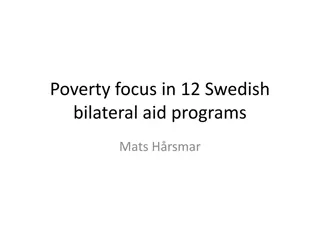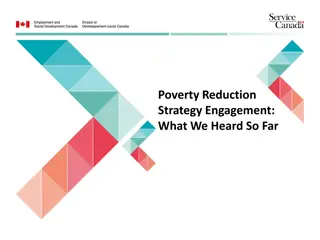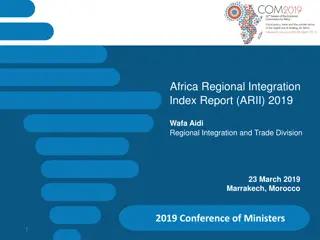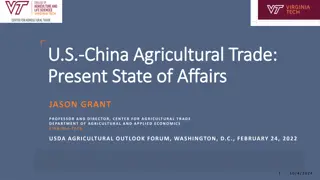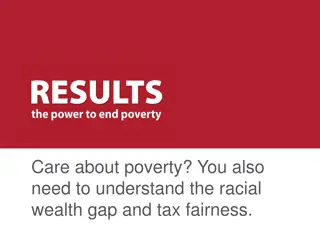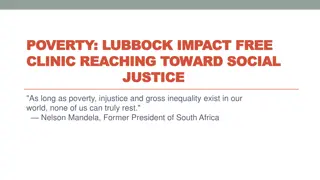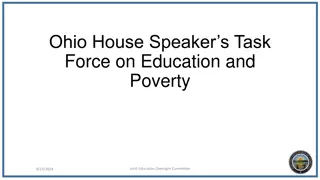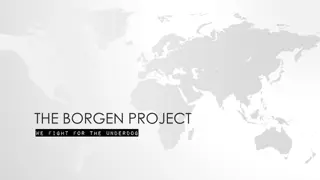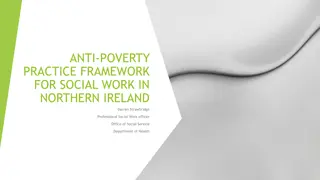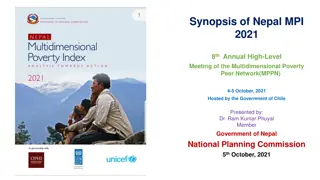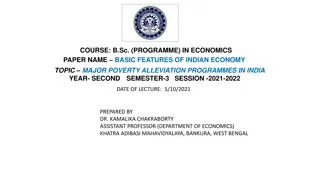Trade and Poverty Reduction in Africa: A Quantitative Analysis
The study explores the relationship between trade and poverty reduction in Africa from 1990 to 2014 using a panel Vector Autoregressive framework. Various channels of influence, such as price/distribution and wages/employment, are examined for their impact on poverty alleviation. Trade liberalization is analyzed within the context of its potential benefits for the poor, highlighting the complexities of its effects on different sectors of the economy.
Download Presentation

Please find below an Image/Link to download the presentation.
The content on the website is provided AS IS for your information and personal use only. It may not be sold, licensed, or shared on other websites without obtaining consent from the author. Download presentation by click this link. If you encounter any issues during the download, it is possible that the publisher has removed the file from their server.
E N D
Presentation Transcript
TRADE AND POVERTY REDUCTION IN AFRICA Fauzel S, Sannassee RV, Seetanah B University of Mauritius
Background Trade has been identified as an important factor reducing poverty by most scholars. To further investigate into the subject, this study made a quantitative analysis between trade and poverty reduction for the case of Africa over the time period 1990-2014. Using a panel Vector Autoregressive framework, both the long run and the short run.
Winters (2000) and McCulloch et al. (2001) put forth a conceptual framework for analysing the relationships between trade, trade liberalisation and poverty. The authors put forward three direct channels of influence which is required to have a clearer picture of the potential impact of liberalisation on poverty. The direct channels set forth are namely: the distribution channel which affects price transmission; the enterprise channel which affects wages and employment; and the government channel which affects taxes and government expenditure
Price/Distribution Channel When country with barriers of protection opens up its trade, the prices of merchandised goods as well as import substitutes are changed. Due to lower tariffs, prices of imports are lowered. Consequently, it helps the poor by keeping prices of substitute s low and increasing people s real income. Accordingly, it may also result in higher export duties. Therefore the impact on the poor is dependent on households are predominantly consumers or producers. Nevertheless, some studies showed that in a number of economies, the poor are predominantly buyers of import goods, hence trade liberalization is expected to benefit the poor (PRUS, 2001).
Wages and Employment Channel the second channel is the influence openness has on labor market and the resulting changes on wages affecting the poor. Labour markets are a key route out of poverty. The impact on labour market depends on elasticity of labour supply (Winters, 2000b:6). If above-mentioned market is perfectly inelastic, then any change in prices relates to change in wages with no change in employment. Winters suggested that in this case, opening trade should surge wages in developing economies and be a panacea to poverty. However, the theorem does not always hold in reality. This view is further supported by Hechscher-Ohlin trade theory that trade liberalisation shall help to alleviate poverty in countries having relatively an abundance of unskilled labour. For instance, trade liberalisation may be bringing skill-biased technical change, which can mean that skilled labour may benefit relative to unskilled labour. It is noteworthy that the unskilled are primarily employed in non-traded sectors, while exports draw mainly on the semi-skilled. Static gains from trade depend to a large extent on adjusting a country s output bundle. Hence some people are prone to suffer temporary unfavourable shocks, most precisely in the form of unemployment. Similarly, According to factor endowment theories of international trade, liberalisation will be pro-poor both in the short run and in the long run. In the short run, poverty will be reduced because the wages of unskilled labour will tend to increase. This happens because countries will tend to export commodities that are using abundant (and therefore relatively cheap) production factors intensively in the production process. This will drive up the demand for and therefore the price of the abundant factor. In the long run, when both capital and labour are mobile across sectors, this effect will be reinforced by reallocation of capital into labour intensive sectors. When a higher share of the capital stock is used in the labour intensive sectors, the scarcity of labour will increase even more, and so will the wages of unskilled labour.
Fiscal/Government Channel Matlanyane and Harmse (2002) pointed out that Trade revenue is affected by the removal of trade barriers, (however) the direction of change is ambiguous and indirectly the vulnerable are affected. A reduction in trade tax receipts to the government results in a fall in government revenues. The spending on the poor, such as social services, health and social security and welfare may suffer. On the contrary, trade reforms that ends up with increased quantum of trade taxes through the easing of trade barriers and tariff levels may result in increased revenue. McCulloch et al. (2001) argue, however, that this may not necessarily have a negative impact on the poor. If the taxes are income taxes, for example, the distributional impact may be positive due to the progressive nature of the tax. It is also important to note that cuts in revenue may not necessarily lead to cuts in expenditure, especially pro-poor and redistributive expenditure. Finally, McCulloch et al. (2001) raise the further issue of whether opening up the economy restricts a government s ability to manage spending and taxation in a way that affects poverty
Empirics Akmal et al. (2007) examined the relationship between trade liberalization and poverty reduction for a developing country, Pakistan. The results showed that in the long run trade openness is good for growth. While in the short run, financial openness reduces poverty. To achieve the major objective of reducing poverty, the government needs to design and implement an active development strategy not only to benefit from openness, but also to help counteract the negative effects of openness. Another noteworthy study examined liberalization of the cotton market in Zimbabwe during the late 1980s and 1990s. The researcher, Winters (2000) observed that before opening trade, the government was a monopsony buyer of cotton from farmers. As a result, the latter paid low prices. Incomes of farmers were low. After liberalization which encompassed elimination of price controls and privatization of the marketing board, there was stronger competition among
On contrary, Liberalization of Zambian maize market had an opposite effect on poverty. Maize producer were cross- subsidies while producers in remote areas were subsidize by prices, set by parastatal firm. These aids lowered the cost of inputs considerably. Moreover, the price set was uniform for all seasons and throughout the country. After the removal of subsidies and privatization of parastatal firm, larger farmers find no effective change in market conditions while small producers were adversely impacted because of price fluctuation. Further, due to a severe deterioration in transportation infrastructure, remote rural markets for corn completely disappeared, leaving poor farmers without proper incomes. From these 2 real life examples, in Zimbabwe, the removal of tax benefited the suppliers of exports. In Zambia, the removal of subsidy resulted in a decline in revenue for producers of the import-competing products. Observing link between trade liberalization and wage inequality, evidence from East Asia pointed out a positive change in income equality after a strong export-led strategy. With the same line of view, Woods (1994) has found evidence of rising demand for unskilled labour and a decline in inequality the Republic of Korea, Taiwan (China), and Singapore after liberalization.
In contrast, in Latin American (Robinson et al, 2006) the opening of domestic markets to external competition is mostly associated with greater wage inequality. Much of the increase in wage inequality and unemployment in several countries over the last two decades has been attributed to the change in the structure of labour demand in favour of skilled workers. This is reflected in the overall increase in the return to education for skilled labour and, in some countries, in the rise of unemployment among less-skilled individuals. On the other hand, Ros and Bouill n (2002) have analyzed the cases of Morocco and Mexico, respectively, and found that reductions in tariff levels and import quotas have had a modest but negative impact on employment, which has partly been the result of firms efforts to cut margins and raise productivity. Ravallion (2007), using both macro and micro modelling, questions the robust link between globalization and poverty reduction. The paper argues that, under a set of specific conditions, trade openness could be effective in reducing poverty. Specifically, cross-country analysis, and a case studies of China and Morocco indicate that it is difficult to assert that trade liberalization is a powerful force for poverty reduction, and that the relationship cannot be generalized in both cases, at either side of the debate. Bhagwati and Srinivasan (2002) and Berg and Krueger (2003) focus on the importance of trade policy for poverty reduction from a macro perspective. The author emphasise principally on the relations between trade and growth to determine the changes in poverty by evaluating the variations in per-capita income. They conclude that generally openness to trade is an important contributor to growth and that growth associated with trade liberalisation is as pro-poor as growth in general.
The basic specification of the model is based on the principles of some earlier studies carried out by Kemal et al (1995), Butt et al (2007) & Shahbaaz et al. (2008) and takes the following functional form POV = f (OPEN,GDP,CPI,GSP, GDEBT, UNEM) --(1)
The poverty headcount index (Seetanah et al, 2009) is used to capture the level of poverty in the countries under consideration. The data has been extracted from the WDI. The variable of interest in this study is the openness variable. It is measured as the ratio of imports and exports to GDP as per Loko et al. (2009). This indicator measures a country s 'openness' or 'integration' in the world economy GDP has been used in the literature (Lee, Jong-Wha. 1994, Sharma & Gani 2004) as a welfare measure to assess the advancement of countries. For instance, the variable government spending (GOVTSP) is added. Normally, for African countries, investment flows mainly from government and or from foreign direct investment. Hence, government spending is used as a proxy to capture government investment Other control variables include inflation (CPI) as a measure of the macroeconomic environment in the selected countries. More so, the variable capturing unemployment rate (UNEM) and a corruption index is as well included in the study to investigate the link between unemployment and welfare
Dependent Variable : LPOV Dependent Variable : LPOV LPOV LPOV LOPEN LOPEN -0.47334*** -0.47334*** LGDP LGDP -0.36828*** -0.36828*** LCPI LCPI 0.782746 0.782746 LSP LSP -0.43942* -0.43942* LDEBT LDEBT 0.20649* 0.20649* LUNEM LUNEM 0.52761** 0.52761**
The long run equation yields quite interesting results and it can be noted that the coefficient of trade openness has a negative relationship with the poverty variable which implies that an increase in trade openness has led to a reduction in the level of poverty in the selected African countries. This result is in line with Winters (2002) who found that trade is generally a strong positive contributor to poverty alleviation as it allows people to exploit their productive potential, assists economic growth, curtails arbitrary policy interventions and helps to insulate against shocks.
Economic growth has also been crucial to reduce poverty in the island. For instance, a 1% increase in real GDP has led to a 0.37% decrease in poverty level. This result is in line with Squire (1993) who regressed the rate of poverty reduction against its rate of economic growth and found that a one percentage increase in the growth rate reduced the poverty headcount ($1 per person per day) by 0.24 percentages. Empirical work from Bruno, Ravallion and Squire (1998) for 20 developing countries and Akmal et al. (2007) for the case of Pakistan also confirmed a negative relationship between trade and poverty reduction.
Error Correction: D(LPOV) D(LOPEN) D(LGDP) D(LCPI) D(LSP) D(LDEBT) D(LUNEM) - -0.00134** -0.00315** - 0.00694* -0.00435 0.00608* -0.01449* 0.00271 CointEq1 0.23159*** 0.17841 0.10105 -0.35783 -0.04821 -0.04541 6.05678 D(LPOV(-1)) -0.00021* 0.21148* 0.89846** 0.11323* 0.01132 -0.03668 1.74179 D(LOPEN(-1)) -0.03439** -0.057184 0.53287 0.11964 -0.56096 -0.00269 -1.244672 D(LGDP(-1)) 0.033842* -0.312278 0.79690 -0.09810* -0.27835 0.29955 0.30324 DLCPI(-1)) -0.006731* 0.012397 0.25112* -0.01693 -0.38950 0.01565* -0.04884 DLSP(-1)) -0.006657 -0.012623 -0.10740 0.15543 0.00522 -0.02377 -0.11765 DLDEBT(-1)) -0.000185 -0.001521 -0.02154 0.00805 -5.24E-0 -0.00097 -0.14096 DLUNEM(-1)) 0.05699 * -0.021608* 0.045436* 0.04377* -0.02269 0.06450 -0.58569 Constant
Analysing the openness variable, it can be noted that in the short run it still has a negative and significant impact on poverty reduction. However, the result is very small. It can hence be argued that trade openness takes time to have its full effect on the level of poverty. On the other hand, government expenditure continues to have the expected result in the short run as well and implies that it is of utmost importance for poverty alleviation in the country. As such government expenditure is validated to be crucial in reducing poverty levels in the short run. On the other hand, inflation is confirmed to fuel poverty in the short run
